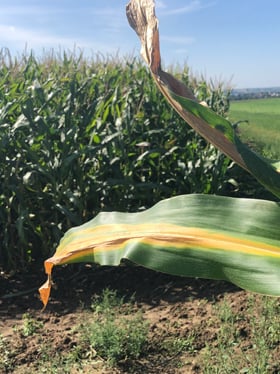Growing Maize
Crop Nutrition Advice
Everything you need to know about maize fertilization, best practice, suitable products, field trials and more.
Crop nutrition advice for growing maize (Zea mays)
-
Maize prefers a soil pH between 6.0 and 7.2, but it performs well in calcareous soils too, of up to 8.5, especially under irrigated conditions, like in southern areas of Europe.
-
Potassium is the nutrient absorbed by maize in the largest amount. The period of intensive uptake of this nutrient begins from the moment of appearance of the 6th leaf (BBCH 16) and continues until full formation of the cob (BBCH 59).
-
On sandy soils there is a possibility the K might be leached out of the rooting zone.
-
Good nutrition of plants with potassium in dry years improves plant resistance to water stress.
-
It is a warm weather crop and therefore performs best when temperatures in the warm months range from 25 – 30ºC.
-
Maize struggles when the mean summer temperature is below 19°C because the mechanism of effective binding of carbon dioxide is activated at temperature 25°C.during periods of flowering and maturation. Mean daily temperatures above 26°C can accelerate germination processes, on the flip side, temperatures below 15.5°C can decelerate them.

Nitrogen deficiency in maize

Yellowing of the leaves showing sulphur deficiency in maize
Nutrient requirements
| N | P2O5 | K2O | Mg | SO3 | Ca | |
|---|---|---|---|---|---|---|
| kg/ha | kg/ha | kg/ha | kg/ha | kg/ha | kg/ha | |
| Average unit intake in kg/t dry grain + straw | 20-33 | 11-14 | 28-37 | 5 | 4 | 7 |
Table 1. Nutrient uptake by maize grown for grain [Grzebisz, 2007]
Dynamic of nutrient uptake over a crop season in maize

Source: modified from Buchner and Sturm 1985 and UNIFA 2015; BBCH scale according to Hack 1993.
Role of nutrients
| Key parameter | N | P2O5 | K2O | MgO | CaO | SO3 |
|---|---|---|---|---|---|---|
| Yield | ++ | + | ++ | + | + | + |
| Number of grain in cob | + | + | ++ | + | + | + |
| Protein content | ++ | + | + | ++ | + | ++ |
| Vegetative growth | ++ | + | + | ++ | + | ++ |
Nutrient deficiencies
Nitrogen
Leaf symptoms: younger leaves turn pale-yellow or light green, uniformly throughout the leaves. Early senescence of tips and mid-ribs. Later, V-shaped yellowing may appear on the leaves’ tips. Yellowing begins on the older lower leaves and progresses up the plant. Stalks are thin and spindly. Flowering- delayed, Low vegetative vigor. Root system becomes less prolific, slowing uptake of other nutrients. Reduced yield due to incomplete cob-tip kernel development.
Phosphorous
Incidence: Insufficient P availability, and reduced uptake by roots due to cold, wet, or compacted soil. Leaf symptoms: Dark green leaves; dark purple/yellow chlorosis, advancing along purple color. Reduced yields, delayed maturity. Slow growth rate, severe dieback.
Potassium
Incidence: Insufficient potassium availability. Leaf symptoms: Dark green plants, show, mainly on their lower leaves, chlorosis along the leaf margins, developing to brown striping and necrosis. In older plants-browning of leaf tips and margins.
Yield: Reduced, due to smaller and cob-tip defective kernels.
Calcium
Leaf symptoms: symptoms start on young leaves, which exhibit a light green colour or whitish spots or streaky lesions and are often hooked back.
Magnesium
Leaf symptoms: Always appear on older leaves. Green-yellow plants with dark yellow interveinal. Chlorosis, advancing to rust-brown or purple necrosis.
Sulfur
Leaf symptoms: Yellow striping pattern on the leaves. Firstly, on the newest leaves, without necrosis. Prominent interveinal chlorosis; veins are prominent over the leaves’ length. Low vegetative vigor.
At advanced stages: plant stunting.
Boron
Leaf symptoms: Yellow, white or transparent necrotic spots. Stalks stunted, due to shortened internodes. Yield: much reduced due to smaller and defective cobs.
Copper
Leaf symptoms: young leaves develop a bluish green tint and come out spiraled of the whorl. Old leaves’ tips and edges wilt, turn white-grey and may die. Some necrosis of older leaf edges, like in K deficiency. Growing points: Dieback, often preceded by shortened internodes. Stalk: soft and limp.
Iron
Leaf symptoms: Chlorosis of interveinal areas, of young leaves of the summer flush, while veins and midrib remain green. At severe cases, the leaves may become almost white. Reduction in size.
Manganese
Leaf symptoms: Young and medium formed leaves become olive-green, and develop uniform, white-yellow stripes in the midsection of the leaf. The stripes become necrotic with the dead tissue falling out of the leaf. Symptoms are like those for iron, and leaf tissue analysis is needed to confirm Mn deficiency.
Zinc
Leaf symptoms: Pale yellowish green chlorotic stripe near the lower half of the leaf, or on each side of the midrib, advancing to pale brown or gray necrosis. Most prevalent at growth stages V2–V8.


Nitrogen deficiency Phosphorus deficiency


Potassium deficiencies


Magnesium deficiency Zinc deficiency


Sulfur deficiencies




